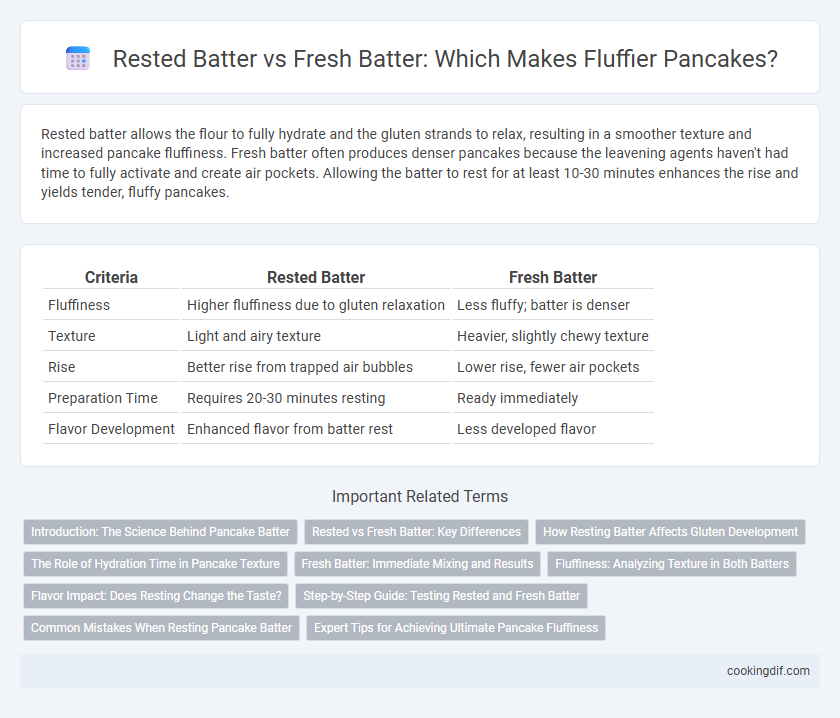Rested batter allows the flour to fully hydrate and the gluten strands to relax, resulting in a smoother texture and increased pancake fluffiness. Fresh batter often produces denser pancakes because the leavening agents haven't had time to fully activate and create air pockets. Allowing the batter to rest for at least 10-30 minutes enhances the rise and yields tender, fluffy pancakes.
Table of Comparison
| Criteria | Rested Batter | Fresh Batter |
|---|---|---|
| Fluffiness | Higher fluffiness due to gluten relaxation | Less fluffy; batter is denser |
| Texture | Light and airy texture | Heavier, slightly chewy texture |
| Rise | Better rise from trapped air bubbles | Lower rise, fewer air pockets |
| Preparation Time | Requires 20-30 minutes resting | Ready immediately |
| Flavor Development | Enhanced flavor from batter rest | Less developed flavor |
Introduction: The Science Behind Pancake Batter
Rested pancake batter allows gluten strands to relax and starch granules to fully hydrate, resulting in a lighter, fluffier texture compared to fresh batter. The resting process also enables leavening agents like baking powder to activate more effectively, producing greater carbon dioxide bubbles that create air pockets within the pancakes. This scientific interaction enhances the batter's viscosity and leads to a tender, airy pancake structure.
Rested vs Fresh Batter: Key Differences
Rested batter allows gluten strands to relax and starch granules to hydrate fully, resulting in a smoother, thicker consistency that traps air better for fluffier pancakes. Fresh batter tends to produce denser pancakes due to less time for leavening agents like baking powder to activate and insufficient hydration. Resting pancake batter for 15-30 minutes enhances texture significantly by promoting chemical reactions that improve rise and tenderness.
How Resting Batter Affects Gluten Development
Resting pancake batter allows gluten strands to relax, reducing toughness and promoting a tender, fluffy texture. During the rest period, hydrating the flour absorbs water fully, improving consistency and gas retention for better rise. This process diminishes excessive gluten development compared to fresh batter, resulting in pancakes with superior lightness and softness.
The Role of Hydration Time in Pancake Texture
Hydration time plays a crucial role in pancake texture by allowing the flour to fully absorb the liquid, resulting in a more cohesive batter. Rested batter, typically set aside for 10 to 30 minutes, promotes gluten relaxation and starch gelatinization, leading to enhanced fluffiness and tenderness. Fresh batter lacks this hydration period, often producing denser pancakes with a less airy crumb structure.
Fresh Batter: Immediate Mixing and Results
Fresh batter yields pancakes with a lighter texture due to the immediate activation of leavening agents like baking powder or baking soda. Mixing the batter just before cooking preserves the carbon dioxide bubbles, resulting in a fluffier and more tender pancake. Immediate cooking prevents the batter from thickening or losing its rising power, optimizing pancake fluffiness and flavor.
Fluffiness: Analyzing Texture in Both Batters
Rested pancake batter enhances fluffiness by allowing gluten strands to relax and starch granules to absorb moisture, resulting in a tender, airy texture. Fresh batter often produces denser pancakes as the gluten remains tighter and less moisture is retained. Measuring fluffiness through rise height and crumb structure consistently shows rested batter yields superior lightness and softness.
Flavor Impact: Does Resting Change the Taste?
Resting pancake batter allows enzymes to break down starches and proteins, enhancing the batter's natural sweetness and creating a more developed, richer flavor. Fresh batter often tastes more neutral and slightly eggy, while rested batter delivers a balanced, mildly tangy profile due to mild fermentation. This flavor transformation contributes significantly to the overall enjoyment of fluffy pancakes.
Step-by-Step Guide: Testing Rested and Fresh Batter
Testing rested versus fresh pancake batter reveals significant differences in fluffiness and texture. Prepare two separate bowls, mixing identical ingredients, then let one batter rest for 15-30 minutes while using the other immediately. Cook pancakes from both batters side-by-side, observing how resting allows gluten to relax and air bubbles to stabilize, resulting in lighter, fluffier pancakes compared to fresh batter.
Common Mistakes When Resting Pancake Batter
Resting pancake batter for 10 to 30 minutes enhances fluffiness by allowing gluten to relax and starch grains to swell, but common mistakes like over-resting can lead to dense pancakes as the leavening agents lose effectiveness. Using too hot or too cold ingredients before resting can disrupt yeast or baking powder activation, resulting in inconsistent texture. Stirring the batter vigorously after resting deflates trapped air, reducing the desired fluffiness and rise during cooking.
Expert Tips for Achieving Ultimate Pancake Fluffiness
Rested batter allows the gluten to relax and the starches to fully hydrate, resulting in lighter, airier pancakes compared to fresh batter. Expert tips recommend letting pancake batter rest for at least 15-30 minutes before cooking to maximize fluffiness. This simple step enhances texture by producing a tender crumb and better rise during cooking.
Rested batter vs fresh batter for pancake fluffiness Infographic

 cookingdif.com
cookingdif.com